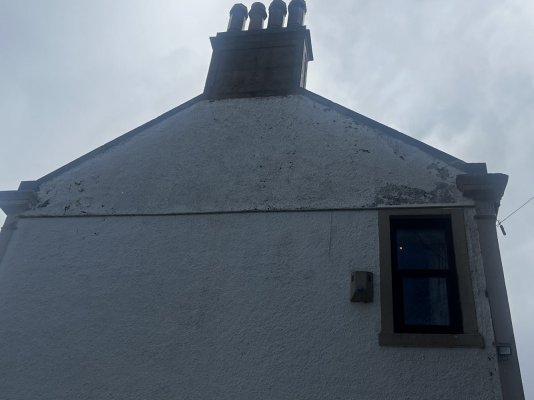Thanks for all the advice! I’ll see how we get with the chimneys and vents and then take it from there. Ideally we would have the coping stones capped with lead to stop them becoming saturated but we might first try again painting them with waterproofing when we get the cherry picker.If you're not seeing condensation on the sarking, then it's less likely that the damp gable end is due to condensation, though if the gable end is already suffering with penetrating damp, condensation may still be a factor as it will be cold from being damp.
We looked at getting a cherry picker to replace my missing clay cowl lid (it had cleared the porch and paving below, landing in soft earth). Because we're on a B road, we would have needed traffic lights and some sort of license, making it even more expensive than scaffolding. Of course scaffolding gave me more time and allowed me to paint the bargeboards. Once I was up there I realised that the crumbly recycled verge slates would benefit from being replaced and the flashing needed sorting anyway, so I was able to do that too.
Not keen on the stonework detailing above the leaky window, lots of scope there for problems with all the ledges and cracks. Not a lot of material above the window to keep it dry either. The interior looks to be modern gypsum plaster in that it's all very sharp edged and apparently pretty brittle. Gypsum plaster really hates damp even though it seems to attract it!
It would be interesting to know the exact nature of the render and masonry paint. In the early days parts of my stone house were repointed in a 1:1:6 cement lime mortar and that hasn't caused any problems that I'm aware of. Problem cement mortars are usually very hard, cement lime mortars quite a lot less hard, lime mortars usually soft and are not prone to shrinkage cracking once set. Unless there are other signs of subsidence those cracks are more likely to be shrinkage which might indicate a cement harling. I'd definitely be wary of any cement filling that's been done of cracks and gaps in the raised stonework on top of the gable end.
I do think you are correct to start with the easiest fix which is to cowl the chimneys, and vent the roof space. If you don't have fireplaces then the flues won't be vented and the salts of combustion in the flue could well be causing problems when washed through that wall.
Unfortunately no clue what the coating is as it was before we moved in but it does seem quite plasticky. It’s also coming away a lot on the other gable end where there are also problems:

Strangely, there doesn’t seem to be cracks in this side, it’s just the coating that has been flaking and coming off. The entire house has the same stuff but it’s just these gable ends that are problematic. On this side only one of the 4 chimneys are capped.
